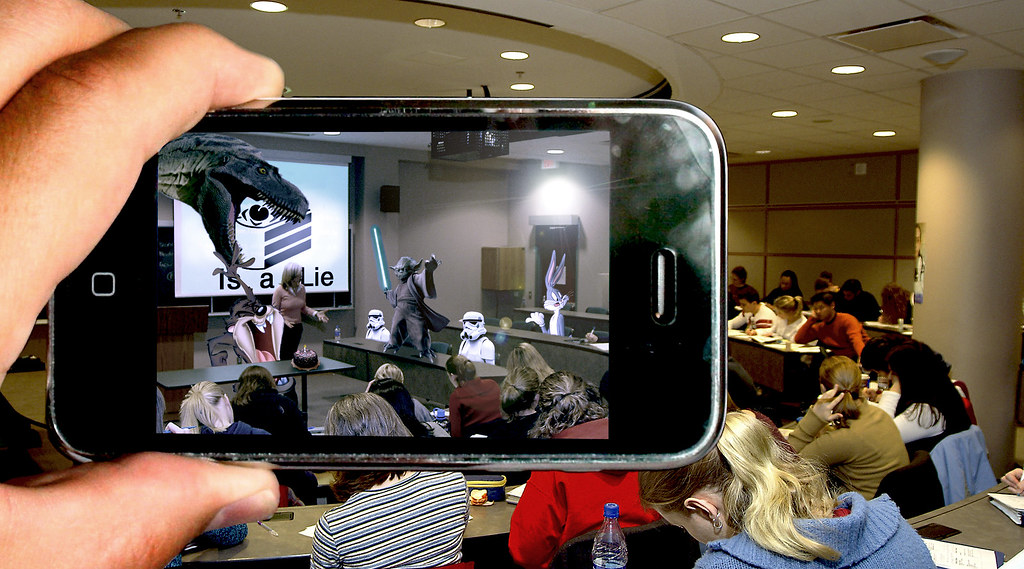Education and the Quest for Cosmic Knowledge Using AR


How we learn, as education system, using Augmented Reality (AR) is something we’re all finding very new indeed. However, it has already started. Clio is an iPad application which can teach us stuff like: how explosions take place in outer cosmos regions, what happens when a star is born and why some cosmic energies fuse.
It illuminates and fascinates the mind at the same time. It is also a great learning tool. Clio’s augmented reality tool is developed to listen to students talk. Then, as they do so, it displays (in full glorious AR visuals) things like a celestial star, a planet, a vast nebula or any item appearing in our huge galaxy.
Clio encourages children and students to speak. From the words it hears, it then forms images onto a table, floor space, a bed or even an outdoor patio area. The lesson itself last just over 8 minutes – but it might just well be the most informative and fascinating science lesson you will ever have.
This software has been around less than a year (released in late 2018) and its intention is for children and students to learn in a fun sort of way. Learning that has an exciting edge to it, almost always means the student will absorb the information with greater alacrity and a more advanced perspective.
Several post-school programs and homework lessons in Los Angeles feature this very software. Children literally interact with character, like rabbits or famous nursery rhyme characters to help advance their learning program.
Much of the AR software used in education in the West Coast faculties has been more of an experiment, rather than the curriculum for the way forward. Education chiefs wanted to see if there was a positive response to it from the children and the teachers. Apparently, it has been a huge success, so far.
The amount of different stories and concepts are now growing. Education is not simply linked to learning about our galaxy and the cosmos, but Little Red Riding Hood and the History of the Stuntwoman – to name but two of the many fascinating and interactive storylines told in AR.
One Third of Developers in AR are Now Focused on Education
According to a report out, commissioned by the XRDC Conference committee, a third of all developers reported their stack and web development structures in AR are centred on education.
A few years back, and this figure would have been well under 5%. Then, it was gaming that was the primary focus driver of AR technology. It still is big. Minecraft Earth and Magic Leap are two augmented reality games with a huge following across the globe.
Wonder Scope
Former music director for giants in the industry like Kayne West and Jack White was an ex-dyslexic called Milk. He is now at the forefront of a new development which uses AR and VR (Virtual Reality) in filmmaking and education.
Milk noted that as a child he would not learn from text books because of his dyslexia and lack of interest. He found spirit and understanding in learning from talking to action man figurines and even mimicking the voice of the toys, as well as himself.
The new venture Milk has now embarked on does just that all over again. In the world of AR, one can speak to a character, who in turn is actually looking directly at you. This is all fascinating stuff. It is almost as if the child’s bedtime book has suddenly been reinvented.
Children as young as seven or eight were admitting to be poor readers and even some had speech impediments. However, after using some of the AR software educational programs, they were like, “where’s the camera? It’s my turn now!”
Confidence and learning ability were all boosted by the AR educational tools that have only just come into the classroom.
Education, AR and the Future
We believe you can see where this is going. Adult education, using AR technology, is going to be huge. Learning in the classroom will allow the tutor to explain a thesis and point to an AR graphic to accelerate the learning process, let alone excite it.
Adults learning a new language can literally try their hand at pronunciation and when they get it wrong, the AR figure will listen, mark and tell you if it is right or wrong.
Boring subjects like Maths and Physics can suddenly become exciting and fascinating to study. It might also save students a lot of money in tuition fees too.





